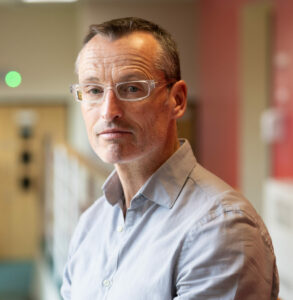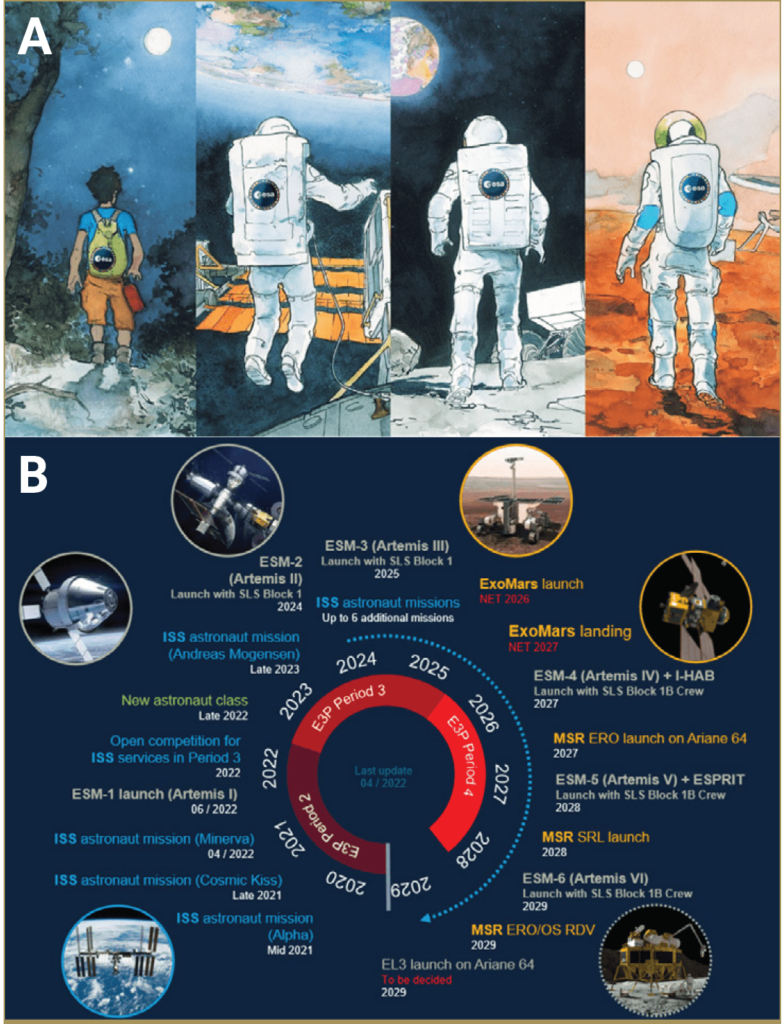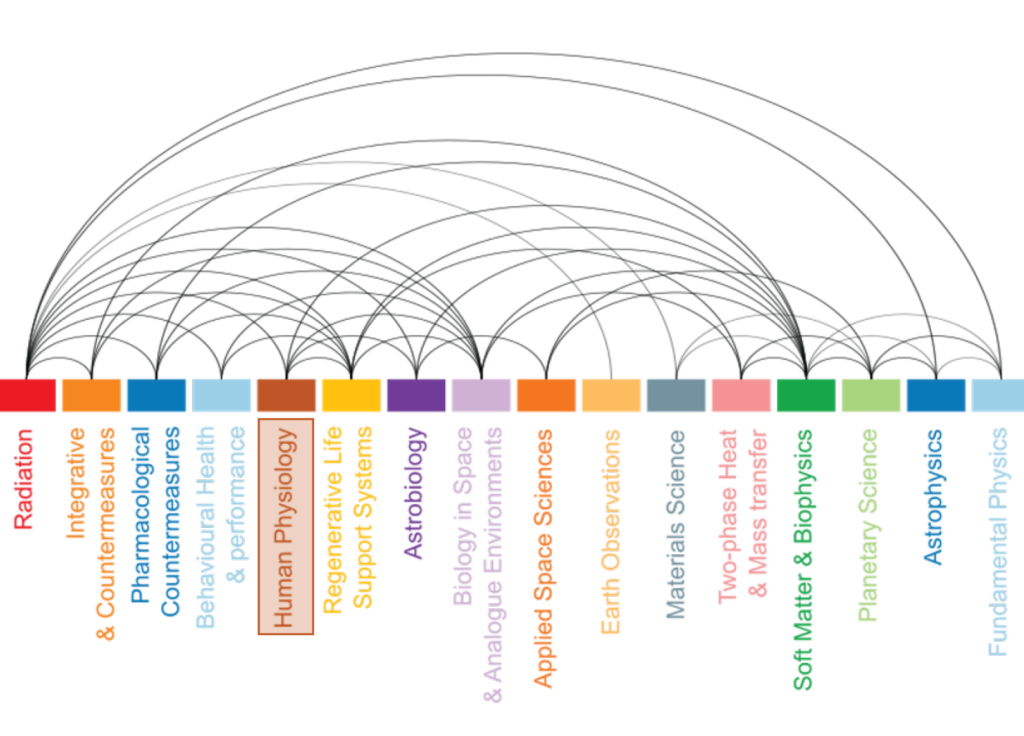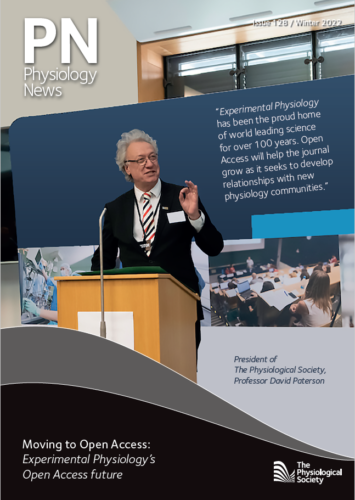
Physiology News Magazine
Inspired by space physiology: Shoot for the stars and believe in the beyond!
Editor-in-Chief, Experimental Physiology
News and Views
Inspired by space physiology: Shoot for the stars and believe in the beyond!
Editor-in-Chief, Experimental Physiology
News and Views

Professor Damian Bailey
Editor-in-Chief, Experimental Physiology
“No one would have believed
In the last years of the nineteenth century
That human affairs were being watched
From the timeless worlds of space
No one could have dreamed that we were being scrutinized
As someone with a microscope studies creatures
That swarm and multiply in a drop of water
Few men even considered the possibility of life on other planets
And yet, across the gulf of space
Minds immeasurably superior to ours
Regarded this Earth with envious eyes
And slowly and surely, they drew their plans against us”
You’re likely all too familiar with this opening verse taken from Jeff Wayne’s musical version of “The War of the Worlds”, first published by H.G. Wells in 1897 and later released by CBS records in 1978 (classified as progressive rock, no less). I was instantly hooked when I got my first taste as an 8-year-old. Narrated by Richard Burton who starred as the “journalist”, that well-known Shakespearean actor whose mellifluous gravelly deep baritone voice, forged in the Welsh Valleys, was simply captivating. And as one of the earliest stories about mankind and aliens, the mélange of science, space and good triumphing over evil set my imagination alight, as Wells openly explored fictional extremes of natural selection.
That childhood spark, fuelled by a fascination for science, space and adventure, has stood the test of time. Some four decades later, an opportunity to perform physiological experiments with the French Space Agency to determine how the brain responds to the micro- (and hyper-) gravity of parabolic flight (Bailey et al., 2020) combined with an appointment to Chair of the Life Sciences Working Group (LSWG) to the European Space Agency (ESA), and as a member of the Human Spaceflight and Exploration Science Advisory Committee (ESA) and Space Exploration Advisory Committee (UK Space Agency), helped fan those formative flames.

Free falling
No words can describe the wonders of weightlessness during the “zero-g” phase of parabolic flight (albeit a meagre 25-30 s worth per parabola!), that fundamental constant that has helped shape our physiology since the dawn of time. The former physiologist-astronaut Dr James (Jim) Pawelczyk who flew aboard the 1998 NASA STS-90 Space Shuttle mission as a Payload Specialist and who described his experiences in an earlier issue of Physiology News (Pawelczyk, 2020), commented, “If you can imagine yourself falling but not feeling any wind, that is exactly the sensation you have of being in space”. Fun freefall aside, it’s the experience leading LSWG, the senior advisory body to the Director of Manned Spaceflight and Microgravity on all matters concerning life and physical science research in space, that has proven the most illuminating. I simply wasn’t aware how omnipresent physiology truly is, not simply shackled to life here on Earth, but permeating “across the gulf of space”, coined by Wells himself.
And the one duty that LSWG was tasked with that really “brought physiology home” involved providing specialist input into ESA’s Human and Robotic Exploration Terrae Novae 2030+ Strategy Roadmap document (ESA, 2022). Its objectives are bold and ambitious, creating new opportunities in low Earth Orbit for a sustained European presence after the International Space Station. It enables the first European to explore the Moon’s surface by 2030 (“boots on the Moon”) as a step towards sustainable lunar exploration in the 2030s in preparation for the horizon goal of Europe contributing to the first historic human voyage to Mars (Fig.1A-B).
Exploring uncharted territories
And when it comes to extreme environments, for which Experimental Physiology has an established track record, space certainly sweeps the superlatives. Since the first human spaceflight by Yuri Gagarin aboard Vostok 1 on 12 April 1961, it has become increasingly clear that the extremes of gravitational shifts, ionising radiation, hypoxia, hypercapnia, celestial dust, decompression sickness, physical inactivity, malnutrition, and confinement pose unique physiological challenges that collectively threaten not only mission success but more importantly, human survival (Afshinnekoo et al., 2020; Bailey et al., 2021; Bailey and Carpenter, 2022). The ambition to push into unchartered territories culminating in a (wo)manned mission to Mars some ~55 to 400 million km from Earth (orbit dependent), has called into action an urgent need to provide deeper “phenotyping” of each of these risks and their integrated physiological impact. A safe return, above all, has to be our number one priority.
To that end, LSWG alongside ~300 specialists have since contributed to the formulation of sixteen “White Papers” reflecting the life/physical science communities’ recommendations on fundamental research questions that warrant consideration within the scope of the Terrae Novae programme as well as enabling exploration and addressing terrestrial applications (ESA, no date). Stand-alone White Papers have been published for Human Physiology (ESA, 2021a) and Integrative and Countermeasures Approach (ESA, 2021b) themes that I encourage you to read and digest; so much food for thought and future experimentation! The latter White Paper is especially impactful since it prescribes a multidisciplinary translational approach to guide and inform the design/implementation of optimised countermeasures to mitigate the physiological risks posed by deep spaceflight (ESA, 2021b).

The promise of wonder and adventure
This exercise highlighted how ubiquitous physiology truly is, transcending numerous themes (Fig.2) forcing a reappraisal and newfound need to understand potential cross links, which has stimulated discussion and collaboration between other research disciplines that have traditionally operated sui generis. This was very exciting and a most rewarding experience, and the collaborations forged once again speak volumes to the “power of physiology” (Bailey, 2022).
And to our younger generation of physiologists, do not fall foul of the same blinkered approach that P.S. Buck, who in his novel The Good Earth openly admitted to, “Like Confucius of old, I am so absorbed in the wonder of Earth and the life upon it that I cannot think of heaven and angels” (Buck, 1931). Space physiology has never been more alive, relevant and adventurous, begging answers to some of the most challenging questions that could also help shed unique insight into our understanding, treatment and prevention of terrestrial diseases, notwithstanding the technological advances. Shoot for the stars and believe in the beyond!
References
Afshinnekoo E et al. (2020). Fundamental biological features of spaceflight: Advancing the field to enable deep space exploration. Cell 183, 1162-1184. https://doi.org/10.1016/j.cell.2020.10.050
Bailey DM (2022). Looking forward to promoting the “power of physiology”. Physiology News, Autumn Issue 127. The Physiological Society, London. https://doi.org/10.36866/pn.127.11
Bailey DM, Ainslie PN, Petersen L and Zu Eulenburg P (2021). Jumping at a chance to control cerebral blood flow in astronauts. Experimental Physiology 106, 1407-1409. https://doi.org/10.1113/EP089648
Bailey DM, Carpenter JD (2022). Oxygen: making molecules for a mission to the Moon and Mars. Experimental Physiology 107, 557-559. https://doi.org/10.1113/EP090463
Bailey DM et al. (2020). Gravitational transitions increase posterior cerebral perfusion and systemic oxidative-nitrosative stress: implications for neurovascular unit integrity. Neuroscience 441, 142-160. http://doi.org/10.1016/j.neuroscience.2020.05.048.
Buck PS (1931). The Good Earth. London Methuen, London, UK.
European Space Agency (2021a). White Paper #12: Human Physiology. Available online at https://esamultimedia.esa.int/docs/HRE/12_HumanResearch_HumanPhysiology.pdf
European Space Agency (2021b). White Paper #15: Integrative and Countermeasures Approach. Available online at https://esamultimedia.esa.int/docs/HRE/15_HumanResearch_Integrative_Countermeasures_Approach.pdf
European Space Agency (2022). Terrae Novae 2030+ Strategy Roadmap. Available online at https://esamultimedia.esa.int/docs/HRE/Terrae_Novae_2030+strategy_roadmap.pdf
European Space Agency. The SciSpacE White Papers. Available online at https://www.esa.int/Science_Exploration/Human_and_Robotic_Exploration/Research/The_SciSpacE_White_Papers
Pawelczyk JA (2020). Space physiology: to Mars and beyond. Physiology News, Issue 117. The Physiological Society, London. https://doi.org/10.36866/pn.117.10
